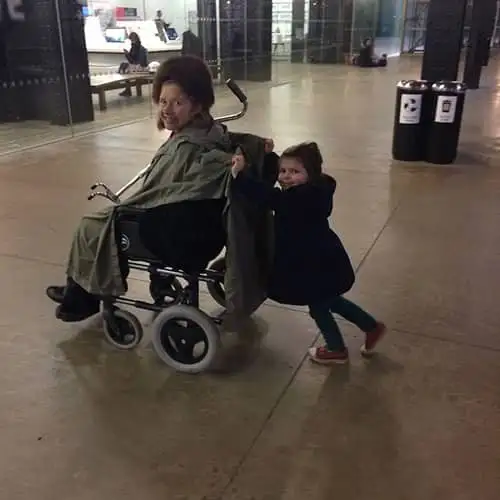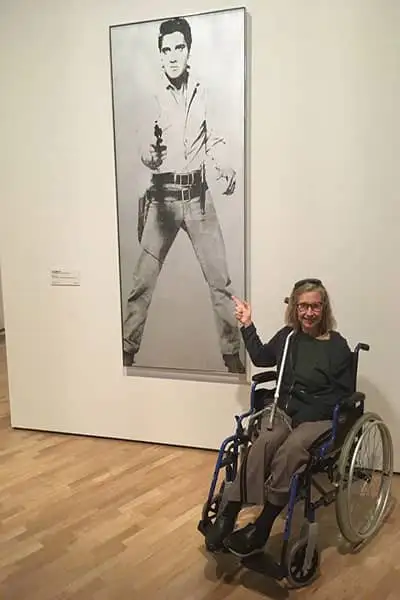Since I became half-paralyzed in 2007 after suffering from a stroke, I have spent more time traveling than I have residing in any once place. Yet when I took that first trip abroad in my wheelchair, a rather alien object I was still getting used to, it was as if it had training wheels attached at the back! My husband, John, young daughter, and I stumbled around New York, Paris, and London the summer after I was released from a six-month stint in hospital with only a mere few months of practice with the whole wheelchair thing. We were left physically and mentally exhausted by the daily difficulties we’d encounter—many we’d have never anticipated. So, for anyone who’s recently found themselves wheelchair-bound, or reliant, I thought I’d share a trick or two that my husband and I have picked up in almost 15 years of traveling, in the hope that it makes your first trip that little bit easier.

Though I have always relished any opportunity to travel, my nomad lifestyle isn’t so much a choice, but a consequence, of an unusual living arrangement. In 2016, my husband and I partnered up with another couple to purchase a former Wesleyan chapel in Greenwich, London. The space is magnificent and works wonderfully as an artist’s studio for both John and our co-owners. Neither of us could afford it independently, but irresistible as it was to us all, we decided to ‘share’ it. Consequently, for the past five years, we have lived in our Greenwich base for six months of the year, after which we travel for the remainder of the year. Tough life, right?
This article will cover the basics of planning a trip—from the initial step of thinking about an itinerary to the practicalities of flying with a wheelchair, and finally booking accessible accommodation. Of course, no two disabilities are the same, but so much wheelchair-travel advice is! Rather than giving concrete ‘do’s and don’t’s’ or a somewhat predictable ‘10 Step Guide to Travelling in a Wheelchair’, I’m just going to relay my personal experiences, and what I’ve learned from them.
Itinerary: Less is More
Rather than spending one month here and another there, I have found that establishing a base, especially as a disabled person, brings far greater comfort and practicality. In our first six months away from Greenwich, we made the mistake of trying to make a sweep of the many southern cities in Spain. Arriving at one destination, unpacking, settling down, only to pack up, drive to the next, and do it all again is extremely taxing, especially for John, who has been left with the great bulk of the work. Yet as soon as we changed our modus operandi and settled into a neighborhood for several months at a time, we felt we actually experienced more of what a country has to offer, without necessarily exploring its every crack and crevasse. We got to know, and be known by, the local people, who would share their treasured knowledge of the hidden gem restaurants, cafes, cathedrals, museums, beaches—all of which we would have missed were we rushing to the next destination.

Flights: Wheels in the Sky
For those of you who use a motorized wheelchair like myself, it is essential you become an expert on the specifications of your chair; not just the dimensions of height and width but weight, and most importantly, exactly what kind of battery (dry/wet) it holds. Later, but before checking in, you must decide whether you will be checking your chair through to your final destination or unloading at any stop in between. and whether you choose to use the manual chair the airport will provide.
Personally, I enjoy the autonomy of having my electric chair to access the terminal, especially duty-free, the newspaper/book shop, and of course accessible toilets. I only surrender my chair at the door of the plane where my husband collapses my chair for the baggage handler to take to the hold with other chairs and prams. Fortunately, I am able to then proceed slowly with my walking stick the relatively short distance to our seats (otherwise there is usually a narrow manual chair of the airlines to push you into place). In short layovers we believe it’s better to take advantage of the free expertise of the airport assistance with the guidance of a local airport assistant who will meet you upon arrival and ensure you get through airport security in time to meet your connecting flight, which can otherwise be challenging in a foreign airport where you may not speak the language… and may even have to take a train to another terminal.
Accommodation
Unless we can book a ground floor or designated ‘accessible’ room, we always enquire about an elevator before booking our intended accommodation. But not all elevators are alike, especially in the desirable historic sections of most European capitals. Oftentimes these are so small that you’d struggle to fit two persons inside, let alone one in a somewhat bulky motorized chair! However, learning the exquisite ancient hotel we wanted to book has an elevator too small for my wheelchair doesn’t deter us. We simply enquire whether there’s a secure storage space in the entrance hall/vestibule where we might be able to leave my wheelchair overnight. This, of course, is possible only as I am fortunate enough to be able to walk, accompanied by my trusted stick, a short distance from an elevator to a room.
Parking
Disability parking permits, or ‘blue badges’ as they are called here in the U.K., are generally accepted internationally, but often at the discretion of individual parking wardens. Even if we decide not to rent a car, we always bring my disability parking permit not just for parking but for possibly gaining access to many streets in historic city centers, oftentimes otherwise closed to vehicles. This enables us to park close to central attractions and avoid long journeys to and from the car. If you do find yourself in a situation of having to cover a great deal of ground covered in cobblestones (as is often the case in the historic areas of most European cities), I suggest covering plastic wheelchair armrests with soft towels, or more simply, wearing long sleeves, as the friction can become rather unpleasant!

In addition, as ridiculous as it sounds, my parking permit acts as ‘verifiable’ proof that I am indeed, really, certifiably disabled. We often use it to get free tickets into art museums, cinemas, and other public attractions. I don’t think I’d have the guts (or motivation) to ask someone in a wheelchair to ‘prove’ their disability, but hey, it’s a crazy world out there!
Public Transport
Can be hit or miss, however, most cities now have good websites containing specific information regarding the accessibility of local public transport. I find sharing information amongst other wheelchair users is the best local knowledge of all. Busses, in general, are usually equipped to facilitate wheelchair users. I have found trains, in particular those underground (such as the New York City Subway or London Underground) to be of greater strain to use efficiently, or altogether inaccessible. Those services which do proclaim to be accessible usually require you to call the station beforehand to arrange for an employee to meet you on the platform, attach a ramp to the train, and the same at the other end, adding a considerable amount of time to your journey.
The Takeaway
In my fifteenth year of disabled travel, I am still impressed by the kindness of more abled strangers, of their selflessness in offering to help in any way they can, some going so far as to offer to literally carry me down (or up!) several flights of stairs.

While perhaps every aspect of traveling in a wheelchair may seem more complicated and time-consuming, there are so many inherent advantages. After returning from our first trip abroad after my stroke, my neurologist in Sydney recommended we immediately begin researching our next trip overseas. He saw the challenges and stimulation of travel, both physical and mental, as tremendous benefits to my recovery.
Related Articles
The World’s Best Places to Retire
